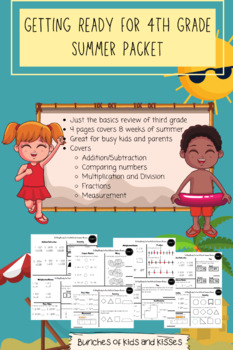Getting Ready for 4th Grade Summer Packet
Bunches of Kids and Kisses
35 Followers
Resource Type
Standards
CCSS3.MD.A.1
CCSS3.MD.B.4
CCSS3.NBT.A.2
CCSS3.OA.A.1
CCSS3.NF.A.1
Formats Included
- Zip
Pages
10 pages
Bunches of Kids and Kisses
35 Followers
What educators are saying
This resource was a great end of the year resource to help my students get read for fourth grade. I was able to use it throughout the week to supplement once we were finished with the math book and testing
Description
To help students avoid the summer slide give them this review packet. This product includes 8 weeks of review work for the summer. Each week, students complete one half of each page. Ideal for busy kids and parents. This can be assigned as a summer math packet to help parents focus on key skills that were learned in third grade and support fourth grade math concepts. An answer key is included.
Total Pages
10 pages
Answer Key
Included
Teaching Duration
N/A
Report this resource to TPT
Reported resources will be reviewed by our team. Report this resource to let us know if this resource violates TPT’s content guidelines.
Standards
to see state-specific standards (only available in the US).
CCSS3.MD.A.1
Tell and write time to the nearest minute and measure time intervals in minutes. Solve word problems involving addition and subtraction of time intervals in minutes, e.g., by representing the problem on a number line diagram.
CCSS3.MD.B.4
Generate measurement data by measuring lengths using rulers marked with halves and fourths of an inch. Show the data by making a line plot, where the horizontal scale is marked off in appropriate units-whole numbers, halves, or quarters.
CCSS3.NBT.A.2
Fluently add and subtract within 1000 using strategies and algorithms based on place value, properties of operations, and/or the relationship between addition and subtraction.
CCSS3.OA.A.1
Interpret products of whole numbers, e.g., interpret 5 × 7 as the total number of objects in 5 groups of 7 objects each. For example, describe a context in which a total number of objects can be expressed as 5 × 7.
CCSS3.NF.A.1
Understand a fraction 1/𝘣 as the quantity formed by 1 part when a whole is partitioned into 𝘣 equal parts; understand a fraction 𝘢/𝑏 as the quantity formed by 𝘢 parts of size 1/𝘣.


